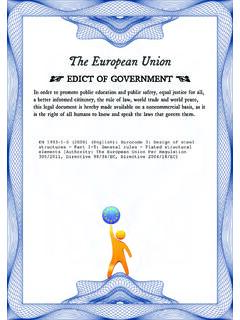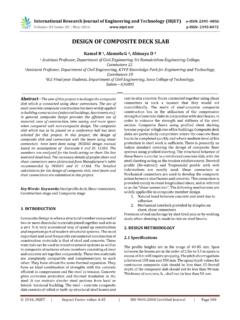Transcription of Design of timber structures - Swedish Wood
1 Design of timber structures Volume 3 1 ExamplesDesign of timber structures Design in the ultimate limit state (ULS) Design of timber jointsComposite timber elementsHorizontal stabilizationDesign for serviceability (SLS)Volume 3 EDITION 2:2016 Design of timber structuresExamples Volume 3 EDITION 2:2016 EditorEric Borgstr mFacts reviewer Eric Borgstr m and Rune KarlssonDesign and productionProService Kommunikation ABIllustrationsCornelia ThelanderVendela MartinacISBN 978-91-980304-4-0 PublisherSwedish Forest Industries FederationSwedish WoodBox 55525SE 102 04 StockholmTel: +46 8 762 72 60 Fax: +46 8 762 79 90E-mail: Design of timber structures Volume 3 PrefaceThis is the second revised edition of Design of timber structures Volume 3, Examples published in 2015. Rules and standards change in pace with the development of society, why a publication of this type has to be reviewed regularly. The book series Design of timber structures Volume 1 3 has been produced to make it easier for structural designers to calculate timber structures and it is adapted to Eurocodes and to Swedish application rules EKS 10 (BFS 2015:6).
2 It is being used for higher education at universities and the book series Design of timber structures Volume 1 3 also Volume 1, Structural aspects of timber construction as well as Volume 2, Rules and formulas according to eurocode 5 are included. All three books are available in English and Swedish . Since the books are available in both languages and due to the nuanced content, our goal is that they will play a role for many users on different skill solved examples in Volume 3 has been compiled by the authors of each chapter in Volume 1 respectively. The authors are Roberto Crocetti, Helena Lidel w, Annika M rtensson and Bert Norlin. Sven Thelandersson at the Faculty of Engineering at Lund University has been responsible for supervision and editing. The solutions to the examples are based on the rules in SS-EN 1995-1-1, but should not be regarded as an official interpretation of them. Professional application must be based on the original documents published by CEN with corresponding national application documents for information about wood, glulam and timber construction can be found at Stockholm.
3 October 2016 Eric Borgstr mSwedish WoodDesign of timber structures Volume 3 5 Del 1 Introduktion till utformning och dimensioneringKonstruktiva egenskaper f r s gat virke och tr baserade kompositprodukterDimensionering av konstruktionselement i brottgr nstillst ndDimensionering av tr f rbandSammansatta tr elementHorisontalstabiliseringDimensione ring f r bruksgr nstillst ndTr byggnadssystem f r bost derKonstruktionssystem f r infrastrukturProjektering av tr konstruktionerDimensionering av tr konstruktionerRegler och formler enligt Eurokod 5 Generella begreppMaterialegenskaperB jningAxiell belastningTv rsnitt utsatt f r skjuvningTv rsnitt utsatt f r kombinerade sp nningarElement med varierande tv rsnitt eller kr kt formBruksgr nstillst ndF rband med f rbindare av metallSkivverkan i tr regelv ggarStagningDel 2 Dimensionering av tr konstruktionerDimensionering av tr konstruktioner Del 3 1 Dimensionering av konstruktionselement av tr i brottgr nstillst nd (ULS)Dimensionering av tr f rbandSammansatta tr elementHorisontalstabiliseringDimensione ring i bruksgr nstillst nd (SLS)Del 3 DimensioneringsexempelDimensionering av tr konstruktionerDimensionering av tr konstruktionerDel 1: Projektering av tr konstruktionerDel 2: Regler och formler enligt Eurokod 5 Del 3: DimensioneringsexempelDesign of timber structures Volume 3 1 ExamplesDesign of timber structures Design in the ultimate limit state (ULS) Design of timber jointsComposite timber elementsHorizontal stabilizationDesign for serviceability (SLS)Volume 3 EDITION 2.
4 2016 Design of timber structures Volume 1 1 Design of timber structures Introduction to Design and Design processStructural properties of sawn timber and engineered wood productsDesign of structural timber elements in ULSD esign of timber jointsComposite timber elementsHorizontal stabilizationDesign for serviceabilityTimber building systems for housingStructural systems for infrastructureStructural aspects of timber constructionVolume 1 EDITION 2:2016 Rules and formulas according to eurocode 5 General conceptsMaterial propertiesBendingAxial loadingCross section subjected to shearCross section subjected to combined stressesMembers with varying cross section or curved shapeServiceability limit statesConnections with metal fastenersWall diaphragmsBracingDesign of timber structures Volume 2 EDITION 2:2016 Design of timber structuresDesign of timber structures Volumes 1 3 are adapted to eurocode 5 and the Swedish application rules EKS 10 (BFS 2015:6). Volume 1: Structural aspects of timber construction Volume 2: Rules and formulas according to eurocode 5 Volume 3: Examples6 Design of timber structures Volume 3 The examples in this textbook are numbered after the matching chapter in Design of timber structures Volume 1.
5 (Chapter 1, 2, 8 and 9 does not contain designing sections.)Chapter 3, Design in the ultimate limit state (ULS) ..7 Example Design of a straight timber joist ..7 Example Bearing strength for the support of a timber joist ..9 Example Capacity of a notched timber beam ..11 Example Lateral torsional buckling check of a glulam beam ..14 Example Design of a double tapered beam (ULS and SLS) ..18 Chapter 4, Design of timber joints ..24 Example Design of tie rod connection ..24 Example Design of nailed connection in a Gerber system ..26 Example Design of bolted connection in tension ..29 Example Design of moment resisting column base ..31 Chapter 5, Composite timber elements ..36 Example Design of an OSB-webbed I-girder (ULS and SLS) ..36 Chapter 6, Horizontal stabilization ..44 Example Design of bracing system for wind load on the gable of an industrial hall ..44 Chapter 7, Design for serviceability (SLS) ..49 Example Design of a straight timber joist with respect to deflection.
6 49 Example Serviceability check of floor with timber joists vibration ..51 Example Serviceability check of floor with glulam elements vibration ..54 Symbols ..58 ContentsContentsDesign of timber structures Volume 3 73 Design in the ultimate limit state (ULS)Example Design of a straight timber joist A simply supported rectangular joist is subjected to characteristic permanent loading, gk = 0,5 kN/m2 and characteristic medium duration variable load qk = 2,0 kN/m2. The clear span l is 4,5 m and the joists are spaced at 0,6 m centres. The joist is part of an indoor floor. Service class 1 and safety class 2. Design the joist in structural timber of strength class C24, for bending moment and shear The characteristic value of bending strength is fm,k = 24 class 2: d = 0, modification factor for load duration and service classes can be taken from Volume 2: Section , with load duration class M and service class 1 the factor kmod = 0, factor for structural timber , M = 1, factor for depth greater than 150 mm, kh = 1,0 (Volume 2: Section ).
7 It can often be reasonable to let the factor kh adopt the value of 1,0 even for smaller sizes of the value of the bending strength: Design value of the load: Design value of the bending moment: Design of a straight timber joist8 Design of timber structures Volume 3 The required section modulus of the joist is given by: A common used width of a timber joist in Sweden is 45 mm. If this is chosen as the width b the required depth h = 214 mm (). A standard section is chosen 45 220 mm. This requires that the joist is braced against lateral torsional buckling by for instance a floor graded particle the shear capacity of the Design value of the shear force: Characteristic value of the shear strength: Thereby is the Design value of the shear strength given by: The Design value of the shear capacity is given by: According to the national annex in Sweden, at present EKS 10 (BFS 2015:6), the value of A should be determined on the basis of bef for a structural element subjected to bending moment.
8 The effective width bef is given by: where kcr = 3,0 fv,k = 0,75 for structural timber C24, not exposed to precipitation and solar radiation. This gives the following for the Design value of shear capacity: This shows that VEd < VRd, that is the joist has sufficient shear : Some way to further reduce VEd is possible, see Volume 2: Chapter of a straight timber joistDesign of timber structures Volume 3 9 Example Bearing strength for the support a of timber joistFor the joist in Example in this Volume, check the bearing strength at the end supports. The bearing length has been restricted to 66 mm at each end. The check for bearing strength is given by: The value of the bearing stress is given by: Aef = b (lb + 0,03) = 0,045 (0,066 + 0,03) = 0,00432 m2 where b is the width of the beam, lb is the actual bearing length and P = Fc,90,d is the force at the support. b = 45 mm lb = 66 mm (according to Example ) Thus the bearing stress is: The characteristic value of the compressive strength is fc,90,k = 2,5 gk qk < 0,4 it is possible to set kmod and M = 1,0, according to Volume 1: Section Design value of the compressive strength is: The factor kc,90 is given by Volume 2: Section : Bearing strength for the support of a timber joist10 Design of timber structures Volume 3 The check is then given by: This shows that the bearing capacity at the end supports is sufficient.
9 The example also shows that the fact that only a minor part of the beam is subjected to compression, allows quite high stresses compared to when a larger area is subjected to compression. If the joist is supported by a timber top plate, the bearing capacity of that of course also have to be strength for the support of a timber joistDesign of timber structures Volume 3 11 Example Capacity of a notched timber beamCheck the capacity of the beam in the figure above with regard to the ultimate limit state. The beam is made of glulam GL30c and the cross section is 90 315 mm. Service class 1, safety class 3 and load duration class M. The Design load has been determined to qd = 5,1 Design bending moment is: The Design shear force is: The characteristic value of the bending strength is fm,k = 30 modification factor for load duration and service classes can be taken from Volume 2: Section , with load duration class M and service class 1 the factor kmod = 0, factor for glulam, M = 1, factor for depths 231 mm h < 600 mm, kh = (600 315)0,1 = 1,07 (Volume 2: Section ).
10 Design value of the bending strength: Figure mm = hef h = 315 mm115 mm = hnotch4,9 mxx5,2 mCapacity of a notched timber beam12 Design of timber structures Volume 3namely the bending moment is limited by: namely the moment capacity is sufficient, provided that the beam is not subject to lateral value of the shear strength fv,k = 3,5 is the Design value of the shear strength given by: The Design value of the shear capacity is given by: According to the national annex in Sweden, at present EKS 10 (BFS 2015:6), the value of A should be determined on the basis of bef for a structural element subjected to bending moment. The effective width bef is given by: where kcr = 3,0 fv,k = 0,86 for glulam, not exposed to precipitation and solar radiation. This gives the following for the Design value of shear capacity: This shows that VEd < VRd that is the beam has sufficient shear the notched areas have to be checked.


